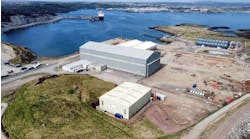UK government signals support for offshore oil and gas
Offshore staff
LONDON – Britain’s Government has announced a new energy security strategy.
The aim is to accelerate the deployment of wind, hydrogen, nuclear and solar energy and to support production of the UK’s oil and gas in the nearer term.
The government plans a licensing round this fall for new North Sea oil and gas projects, with a special taskforce providing assistance to new field developments.
As for offshore wind, the new target is installed capacity of up to 50 GW by 2030 with up to 5GW supplied by floating offshore wind in deeper seas.
New planning reforms should reduce approval times for new offshore wind farms from four years to one year, with other streamlining measures cutting the time taken for new projects to reach the construction stage.
In addition, the government is seeking to develop up to 10 GW of low-carbon hydrogen production capacity by 2030. At least half should come from green hydrogen and use of excess offshore wind power to lower costs.
The new strategy should support 90,000 jobs in offshore wind by 2028 – 30,000 more than previously expected – and 12,000 jobs in the UK hydrogen industry by 2030. There was no comment from the government on the likely impact of the initiatives on the UK’s offshore oil and gas sector.
Offshore Energies UK (OEUK) welcomed the announcement of a new oil and gas licensing round, having pushed consistently for greater support for UK oil and gas while simultaneously expanding offshore wind.
Chief executive Deirdre Michie said: “The UK has enough proven oil and gas reserves to support the UK for at least 15 years, but we need regulatory approval to invest in the platforms, pipelines and other infrastructure needed to access it.
“The announcement of a new licensing round and the proposal to cut the time needed to get those approvals, by the introduction of regulatory accelerators, will help our industry carry on providing the UK with the energy it needs…
“We are delighted at the proposals for a five-fold increase in offshore wind and a doubling of the ambition for low-carbon hydrogen by 2030. However, this is a very ambitious plan, and we should be under no illusion about the mammoth task and costs ahead for the industry, the government and potentially for consumers too.”
The government also plans to create the Future System Operator (FSO), providing oversight of the development of the UK’s energy suppliers and networks, covering both gas and electricity.
OEUK said it had consistently called for greater emphasis on long-term planning and preparation in UK energy infrastructure, as virtually all energy infrastructure takes many years to plan and construct.
Sam Laidlaw, executive chairman of Neptune Energy, one of the UK’s leading E&P independents, said: “The Energy Security Strategy breathes new life into the North Sea, giving investors confidence to allocate significant capital to the diverse range of energy supply we will need through the energy transition. UK energy projects are national priorities – and the country cannot wait.
“Neptune Energy will invest to support these priorities. Immediately, we are increasing production from our Duva field in Norway – enough gas to heat an additional 350,000 homes in this country. In the mid-term, we will bring on further supply from our Seagull field in the UK North Sea, starting early next year.
“And longer-term, with our partners, we’ve agreed to invest $100 million in drilling an appraisal well at the Isabella discovery in UK waters.”
Dr. Andy Samuel, North Sea Transition Authority’s Chief Executive, said:
“I am personally pleased to see focus on demand reduction with the clear target of reducing gas usage 40% by 2030. It is important that we continue to meet the UK’s declining needs with secure domestically produced oil and gas, which has a lower carbon footprint than most imports, while weaning ourselves off gas use and scaling-up renewables as quickly as possible.
“Oil and gas currently supply around 3/4 of our energy needs and will continue to be essential for decades to come. That is why we plan to hold a licensing round later this year – taking into account the government’s Climate Compatibility Checkpoint – and steward new oil and gas developments into production – bolstering energy security and resilience.
“Equally we expect capital to be reinvested in energy transition projects from electrification through to carbon capture and clean hydrogen.”
The Authority is working with government, industry and other regulators to accelerate North Sea energy integration, Samuel said. “The call for greater pace on floating wind projects is welcome – offering exciting opportunities for the supply chain and we want to see clean power supplied to two offshore oil and gas hubs by 2027.
“We are also currently preparing the UK’s first-ever carbon storage licensing round, as we ramp up our licensing activity to support the capture of 20-30 million metric tons [22-33 MM tons] of CO2 per year by 2030.”
Shell CEO Ben van Beurden, said: “This is a once-in-a-generation opportunity to ensure an orderly transition to net zero while bolstering the UK’s energy security and Shell is ready to play our part.
“We plan to invest up to £25 billion [$32.58 billion] in the UK energy system over the next decade subject to board approval, and more than 75% of this is for low and zero-carbon technology. Offshore wind, hydrogen and CCS will all be critical but we need the right policy frameworks in place.”
The Offshore Wind Industry Council (OWIC) has welcomed the plan for a fivefold increase in the UK’s offshore wind capacity to 50 GW by 2030.
OWIC’s co-chair Danielle Lane, Vattenfall’s UK country manager, said: ““To achieve this the planning process needs to be far more agile than it is currently, so we particularly welcome his commitment to ensure that consenting decisions will take no more than a year in future…
“We also need to see faster progress on installing vital new grid infrastructure so that we can make the most of the enormous amounts of clean electricity we’re generating offshore. Innovative technologies like floating wind and green hydrogen also have key roles to play.”
4.18.2022



